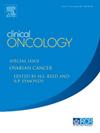Impact of Geriatric Assessment on Radiotherapy Intensity in Older Patients With Nonmetastatic Cancer: A Multi-institutional Study
IF 3
3区 医学
Q2 ONCOLOGY
引用次数: 0
Abstract
Aims
This study prospectively investigated an appropriate geriatric assessment tool for predicting the decisions by radiation oncologists to reduce radiotherapy intensity.
Materials and methods
We enrolled patients with nonmetastatic cancer (aged ≥70 years) in this multicenter study. Reduced-intensity radiotherapy implied changes to the irradiation field and/or radiotherapy schedule from the standard based on the primary tumour guidelines. Geriatric assessment was performed by calculating the Geriatric 8 (G8) and Vulnerable Elders Survey (VES-13) scores before radiotherapy and at 3 to 5 and 8 to 16 weeks post radiotherapy. The primary endpoint was to evaluate the correlation between vulnerability, assessed by G8 score, and changes in radiation intensity.
Results
Between November 2020 and February 2022, 317 patients from 13 centres in Japan were included in this study. The median patient age was 77 years (range: 70-90 years). The primary cancer sites were the head and neck and oesophagus, lungs, breasts, pancreas, bladder, uterus, and prostate in 63 and 22, 62, 48, 6, 5, 26, and 85 patients, respectively. Reduced intensity of radiotherapy was administered to 31 patients (10%); planned radiotherapy was completed in 312 patients (98%). High-precision radiotherapy was administered to 199 patients (63%). The treatment policy was modified in 87 patients (27%). Among these, 77 patients (89%) underwent a reduction in the intensity of concurrent chemotherapy. Grade 3 or higher acute adverse events were observed in 48 patients (15%), with 26 (54%) requiring inpatient treatment. Before radiotherapy, vulnerability was found in 201 (63.4%) and 61 (19.2%) patients based on G8 and VES-13 assessments, respectively. A multivariate analysis revealed that a reduction in radiation intensity was significantly associated with vulnerability assessed using the VES-13 score (P = 0.03) but not the G8 score (P = 0.63).
Conclusion
Geriatric assessment by the G8 score did not predict a reduction in radiation intensity or incompletion in older patients with cancer.
老年人评估对老年非转移性癌症患者放疗强度的影响:一项多机构研究
目的:本研究前瞻性地研究了一种合适的老年评估工具,用于预测放射肿瘤学家降低放疗强度的决定。材料和方法在这项多中心研究中,我们招募了年龄≥70岁的非转移性癌症患者。低强度放疗意味着根据原发肿瘤指南改变辐照场和/或放疗计划。在放疗前、放疗后3 ~ 5周和8 ~ 16周,通过计算Geriatric 8 (G8)和Vulnerable Elders Survey (VES-13)评分进行老年评估。主要终点是评价以G8评分评估的易感性与辐射强度变化之间的相关性。在2020年11月至2022年2月期间,来自日本13个中心的317名患者被纳入本研究。患者中位年龄为77岁(范围:70-90岁)。原发癌部位为头颈部、食道、肺、乳房、胰腺、膀胱、子宫和前列腺,分别为63例、22例、62例、48例、6例、5例、26例和85例。降低放疗强度31例(10%);312例患者(98%)完成了计划放疗。199例(63%)患者接受高精度放疗。87例(27%)患者修改了治疗策略。其中,77名患者(89%)接受了同时化疗强度的降低。48例(15%)患者观察到3级或以上急性不良事件,26例(54%)患者需要住院治疗。放疗前,根据G8和VES-13评估,分别有201例(63.4%)和61例(19.2%)患者发现易损。多变量分析显示,辐射强度的降低与VES-13评分评估的易损性显著相关(P = 0.03),但与G8评分无关(P = 0.63)。结论:G8评分的老年评估不能预测老年癌症患者放疗强度的降低或放疗不完全。
本文章由计算机程序翻译,如有差异,请以英文原文为准。
求助全文
约1分钟内获得全文
求助全文
来源期刊

Clinical oncology
医学-肿瘤学
CiteScore
5.20
自引率
8.80%
发文量
332
审稿时长
40 days
期刊介绍:
Clinical Oncology is an International cancer journal covering all aspects of the clinical management of cancer patients, reflecting a multidisciplinary approach to therapy. Papers, editorials and reviews are published on all types of malignant disease embracing, pathology, diagnosis and treatment, including radiotherapy, chemotherapy, surgery, combined modality treatment and palliative care. Research and review papers covering epidemiology, radiobiology, radiation physics, tumour biology, and immunology are also published, together with letters to the editor, case reports and book reviews.
 求助内容:
求助内容: 应助结果提醒方式:
应助结果提醒方式:


